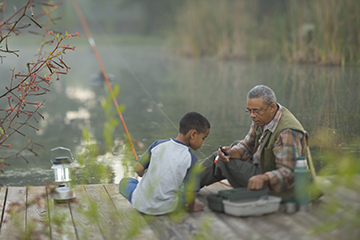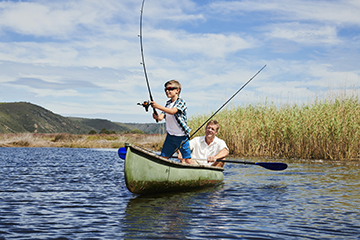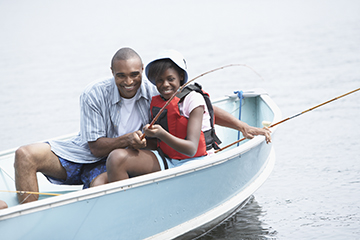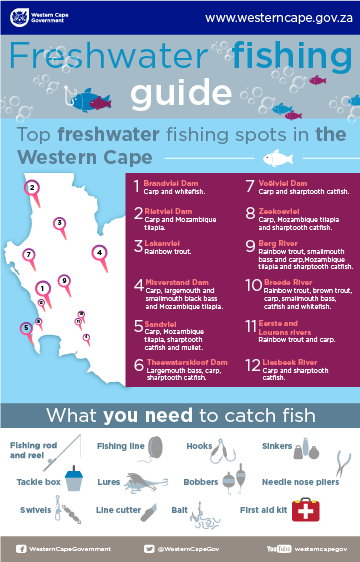Fishing in the Western Cape
 Fishing is one of those activities that everyone should try at least once in their life. If you want an activity that is fun, easy to learn and affordable then fishing is what you're looking for. You can head to one of the many rivers, natural dams and coastal towns in our province and discover the joys of fishing.
Fishing is one of those activities that everyone should try at least once in their life. If you want an activity that is fun, easy to learn and affordable then fishing is what you're looking for. You can head to one of the many rivers, natural dams and coastal towns in our province and discover the joys of fishing.
Fishing is more than just a sport; it is a skill that can be passed down from one generation to the next. It also gives you the opportunity to enjoy the natural beauty of the Western Cape while you bond with your friends or family.
Before you pack your fishing gear, here’s what you need to know about fishing licenses, locations and more.
Freshwater fishing
There are many freshwater fishing locations in the Western Cape where you can catch different kinds of fish including:
- Carp,
- trout,
- catfish,
- bass,
- and Mozambique tilapia.
The different locations where the public can go fishing are:
- Brandvlei Dam: carp and whitefish
- Rietvlei: carp and Mozambique tilapia
- Lakenvlei: rainbow trout
- Misverstand Dam: carp, largemouth and smallmouth blackbass and Mozambique tilapia
- Sandvlei: carp, Mozambique tilapia, sharptooth catfish and mullet
- Theewaterskloof Dam: largemouth bass, carp, sharptooth catfish
- Vöelvlei: carp and sharptooth catfish
- Zeekoevlei: carp, Mozambique tilapia and sharptooth catfish
- Berg River: rainbow trout above Franschhoek. Above Paarl the river contains smallmouth bass and carp. The remainder of the river contains carp, Mozambique tilapia, sharptooth catfish and smallmouth bass.
- Breede River: rainbow trout dominate its mountain streams flowing into it (e.g. Elandsplaat, Holsloot and Molenaars rivers) but brown trout dominate the upper Witte River. The Breede River provides excellent angling for carp, smallmouth bass, catfish and some whitefish.
- Eerste and Lourens rivers: rainbow trout are common in the sections above Stellenbosch and Somerset West respectively. Carp are common in the middle and lower parts of the river.
- Liesbeek River: The lower reaches have large numbers of carp and sharptooth catfish.
 Visit the CapeNature website for more detail.
Visit the CapeNature website for more detail.
You’ll need a license to fish in public rivers and dams. Licenses can be obtained from CapeNature, who is responsible for biodiversity conservation in the Western Cape, and are valid for 12 months from the date of issue.
To apply for one, you can contact the head office at 087 087 9262 or one of the CapeNature regional offices:
- George: (044) 802 5300
- Hermanus: (028) 316 3338
- Driftsands: (021) 955 5940
- Oudtshoorn: (044) 203 6300
- Porterville: (022) 931 2900/7
- Robertson: (023) 625 1621
- Stellenbosch: (021) 866 1560
You don't need a license to fish in a privately owned dam, but make sure to get permission from the owner beforehand.
The Western Cape coastline stretches along both the Atlantic and Indian oceans, our province is also home to a number of fishing villages dotted with fishing spots along the coast. If you head to the coast to catch fish, you should follow these regulations:
- Get a fishing permit from an office authorised by the national Minister of Agriculture, Forestry and Fisheries.
- You aren't permitted to sell and trade fish.
- You need to use a rod, reel and line only, and follow the angling regulations when fishing.
- Your cast net mustn't be larger than 6 meters in diameter.
- If you've approval for spearfishing, you're allowed to catch fish of Class Pisces (that's bony fish, sharks, rays, skates and chimaeras) with a spear gun only.
- You're allowed to fish from a vessel (like a boat) provided that you've approval to fish from a vessel.
Remember, there are specific regulations for different types of fishing.
Where can you get a permit?
You need a permit to fish along the shoreline. Annual and temporary permits can be purchased from the Department of Agriculture, Forestry and Fisheries.
Where can you fish?
Great shoreline fishing spots in the Western Cape are:
- False Bay: bluefin and yellowfin tuna
- Rooikrans: blacktail, hottentot and kob (kabeljou).
- Kommetjie Bay: white steenbras, stumpnose, tuna and albacore by boat
- Hout Bay: snoek, tuna and crayfish
- Melkbosstrand: steenbras, kob and blacktail
- Langebaan: black marlin, broadbill and sand shark
Be responsible
To ensure that you and others can enjoy this pastime in the future, it is important to be responsible and treat the environment with respect. Please keep in mind the following:
- Remember to clean up after yourself.
Litter is hazardous to marine life and people. Remember to remove plastic, waste, lines/nets and sharp items (like hooks) before you leave an area. - You’re sharing the environment with many other animals.
So remember that other animals can unintentionally get caught on your line. If you accidentally catch a bird, or a turtle, please take precaution and gently remove the hook from the animal. - Fish are living beings that can feel pain, so please remove hooks from your catch.
If you’re planning to release after your catch please safely remove the hook from the fish to ensure your catch doesn't suffer. Keep a tackle box with your line/side cutters and pliers close by to make sure you can do this process quickly and not cause the animal too much stress.
Recording a tagged fish
 Some fish are tagged for scientific research. By tagging certain fish, researchers can monitor population sizes, its health and study its movement.
Some fish are tagged for scientific research. By tagging certain fish, researchers can monitor population sizes, its health and study its movement.
According to the World Wildlife Fund’s (WWF) FishforLife, if you catch a tagged fish you must report it to the Oceanographic Research Institute (ORI). Tags come in different shapes and colours and will usually contain information that has to be recorded.
Here’s what you have to do if you caught a tagged fish:
- Record the species. If you’re uncertain, take a clear photograph to help identify the fish.
- Measure the exact length of the fish, i.e. from the tip of the nose to the fork or the end of the tail. If a measuring tape isn't available, use a piece of fishing line, cut it off at the relevant point and measure it later.
- Record the exact location where the fish was recaptured.
- Record the date of the recapture.
- Provide the angler’s name and contact details. State whether the tagged fish was kept or re-released.
- A unique tag number that is usually duplicated on the top and the bottom end of the tag is normally preceded by a letter (A, B, D or M). If the tag number is illegible, try to carefully remove the tag before you release the fish.
Marine protected areas
Marine protected areas (MPA) are protected sections of seas, oceans, estuaries or large lakes. These marine areas can range from wildlife refuges to research facilities. MPAs restrict human activity for conservation purposes, typically to protect natural or cultural resources.
There are 13 MPAs in the Western Cape including (bold indicates MPAs managed by CapeNature):
- Rocherpan (controlled zone)
- Marcus Island (controlled zone)
- Malgas Island (controlled zone)
- Jutten Island (controlled zone)
- Langebaan Lagoon (controlled and restricted zones)
- Sixteen Mile Beach (controlled zone)
- Table Mountain National Park (controlled and restricted zones)
- Helderberg (restricted zone)
- Betty’s Bay (controlled and restricted zones)
- De Hoop (restricted zone)
- Stilbaai (controlled and restricted zones)
- Goukamma (controlled zone)
- Robberg (controlled zone)
Each MPA is demarcated into either a controlled or a restricted zone:
- In a controlled zone (also known as an open area) you’re allowed to extract or harvest if you have the required permit and licenses.
- In a restricted zone (also known as a ‘no take’ area) you’re not allowed to remove any plant or animal life in the area.
Some MPAs have areas marked as both controlled and restricted, each with its own rules regarding fishing (and human activity in general). For example, within the Betty’s Bay MPA no fishing is allowed with the exception of shore angling (subject to valid permits) between the beacon at Stony Point and the beacon to the east of Jock’s Bay. In the De Hoop MPA absolutely no fishing is allowed.
Please contact CapeNature or the South African National Biodiversity Institute (SANBI) to find out more information regarding MPAs.
The South African Sustainable Seafood Initiative (SASSI)
To make sure that fishing remains sustainable and that there's fish for everyone in the future, the World Wide Fund for Nature (WWF) established the South African Sustainable Seafood Initiative (SASSI). Before you go fishing make sure which fish can or can’t be caught. Keep a copy of the sustainable seafood guide with you. This guide indicates which species are green, orange or red according to their vulnerability.
- Green is the best choice. These are the most sustainable choices from the healthiest and most well-managed fish populations, and farmed or fished in a way that does not harm the environment,
- Orange means think twice. There are reasons for concern about the fish on this list either because the species is depleted due to overfishing and cannot sustain current pressure or the fishing/farming method poses harm to the environment, and
- Red means do not buy. These species have extreme environmental concerns. Some species on the red list may be endangered, threatened or vulnerable. Some of these species are specially protected and are illegal to buy or sell in SA.



